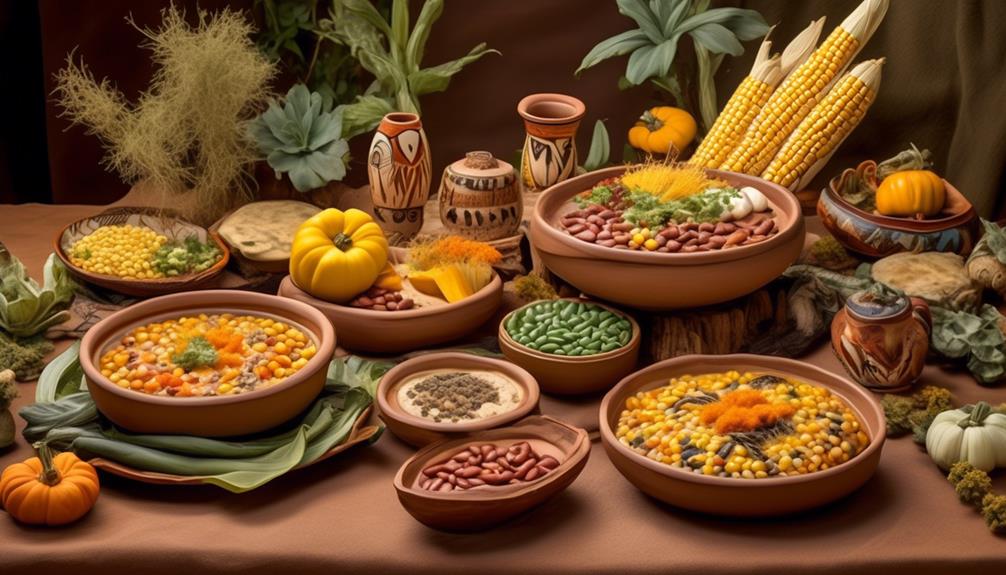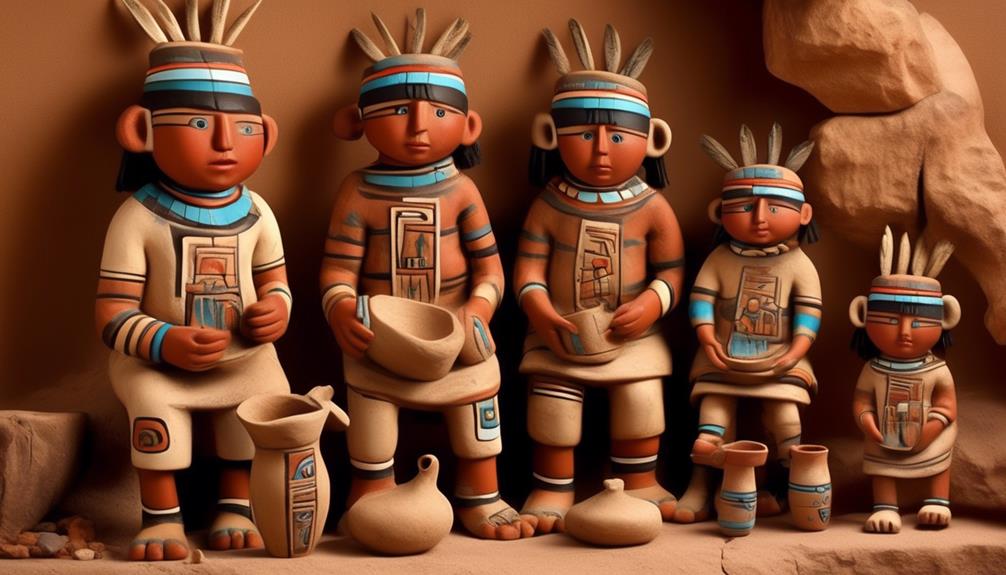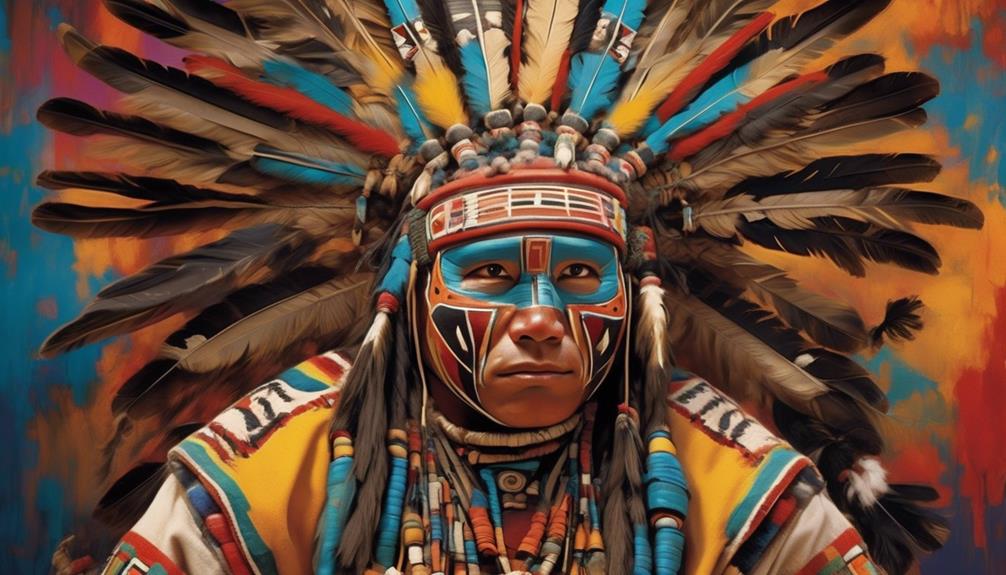While delving into history, we discover the varied cuisine of the Hopi Native American tribe, mirroring the hues of a desert sunset.
Their culinary traditions offer a glimpse into a world where sustenance was more than just a means of survival; it was a sacred connection to the land and their ancestors.
But what exactly sustained these ancient peoples, and how did they manage to thrive in the arid landscapes of the American Southwest?
Let's delve into the fascinating array of foods that sustained the Hopi tribe and shaped their way of life.
Key Takeaways
- Maize (corn) was a revered crop in the Hopi Indian Tribe's agricultural traditions and played a significant role in their diet and religious ceremonies.
- The Hopi skillfully foraged for a diverse array of wild edible plants to supplement their diet, including wild spinach, lamb's quarters, wild onions, amaranth, prickly pears, wild sunflowers, and chia seeds.
- The Hopi relied on their deep knowledge of the natural world to sustain themselves through hunting game such as deer, rabbits, and small game birds, as well as gathering wild plants and seeds.
- Hopi cooking methods included roasting, steaming, baking, boiling, and grilling, and preservation techniques involved drying, smoking, fermentation, pickling, and canning. Traditional recipes like Piki Bread, Hominy Stew, Blue Corn Mush, Bean and Squash Stew, and Sunflower Seed Cakes were passed down through generations.
Staple Crops
The cultivation of staple crops was an essential aspect of the Hopi Indian Tribe's sustenance and cultural practices, shaping their diet and way of life. Maize, commonly known as corn, held a revered position in their agricultural traditions. The Hopi people cultivated various types of maize, each with its specific uses and significance in religious ceremonies.
The maize cultivation process involved meticulous planning, planting, and harvesting, with each stage deeply intertwined with their cultural beliefs and practices. The beans grown by the Hopi were also of great importance. The cultivation of beans complemented maize farming and provided a vital source of protein in their diet.
The Hopi developed intricate agricultural techniques, such as companion planting, where beans were interplanted with maize to enhance soil fertility and yield. This symbiotic relationship between maize and bean cultivation highlights the depth of the Hopi's agricultural knowledge and the cultural significance of these staple crops.
Their deep connection to the land and their rich agricultural practices continue to be integral to the identity and heritage of the Hopi Indian Tribe.
Wild Edible Plants
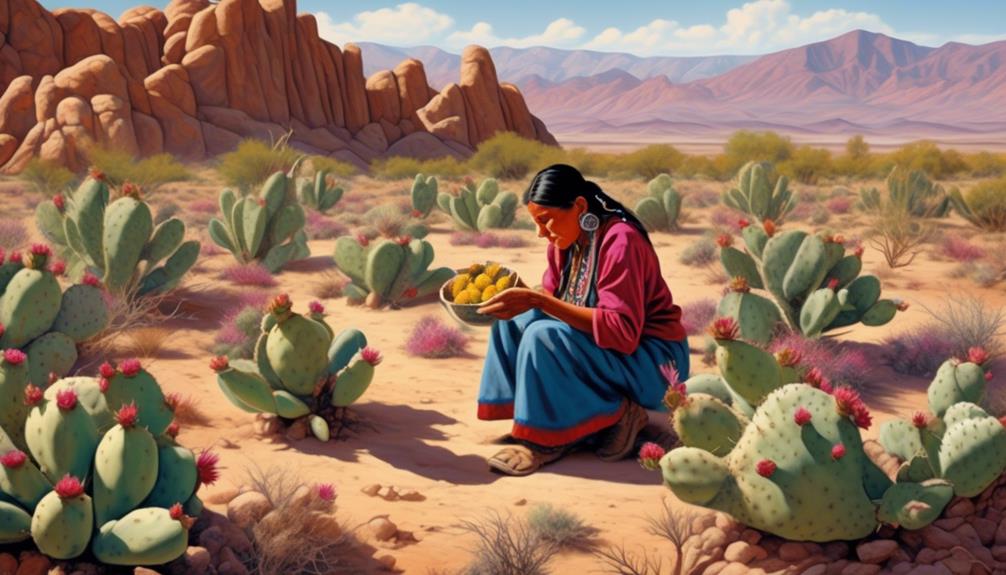
Cultivating a deep understanding of the natural environment, the Hopi people skillfully foraged for a diverse array of wild edible plants to supplement their diet and uphold their cultural traditions. Foraging techniques were passed down through generations, with an emphasis on sustainable harvesting to ensure the plants' continued abundance.
The seasonal availability of wild edible plants played a crucial role in the Hopi diet, with different species being harvested at specific times of the year. In spring, wild spinach and lamb's quarters were gathered, providing essential vitamins and minerals after the scarcity of winter. Summer brought an abundance of wild onions, amaranth, and prickly pears, adding flavor and nutrients to meals.
As the seasons shifted to fall, wild sunflowers and chia seeds were harvested, offering a good source of proteins and healthy fats. These wild plants not only contributed to the Hopi's nutritional needs but also held cultural significance, featuring in traditional recipes that have been preserved and cherished over centuries.
The Hopi's deep connection with the land is evident in their sustainable foraging practices and the culinary legacy of incorporating wild edible plants into their diet.
Hunting and Gathering
Skillfully navigating the diverse terrain of their ancestral lands, the Hopi people relied on their deep knowledge of the natural world to sustain themselves through hunting and gathering practices. The Hopi utilized their understanding of animal behavior and migration patterns to effectively hunt game such as deer, rabbits, and small game birds. They employed various hunting techniques, including the use of snares, traps, and bows and arrows, showcasing their expertise in the art of hunting.
In addition to hunting, the Hopi tribe practiced gathering wild plants and seeds, which were crucial for their sustenance. They foraged for a variety of wild edible plants, including amaranth, cattail, and various types of berries. The seasonal availability of different plants and animals significantly influenced the Hopi's hunting and gathering practices. They adapted their methods to the changing landscape, ensuring a sustainable supply of food throughout the year.
Food preservation was paramount for the Hopi people to endure periods of scarcity. They employed various methods such as drying, smoking, and storing food in underground pits to ensure a steady supply of nourishment during lean times. This careful balance of hunting, gathering, and food preservation techniques allowed the Hopi to thrive in the challenging desert environment.
Food Preparation Techniques
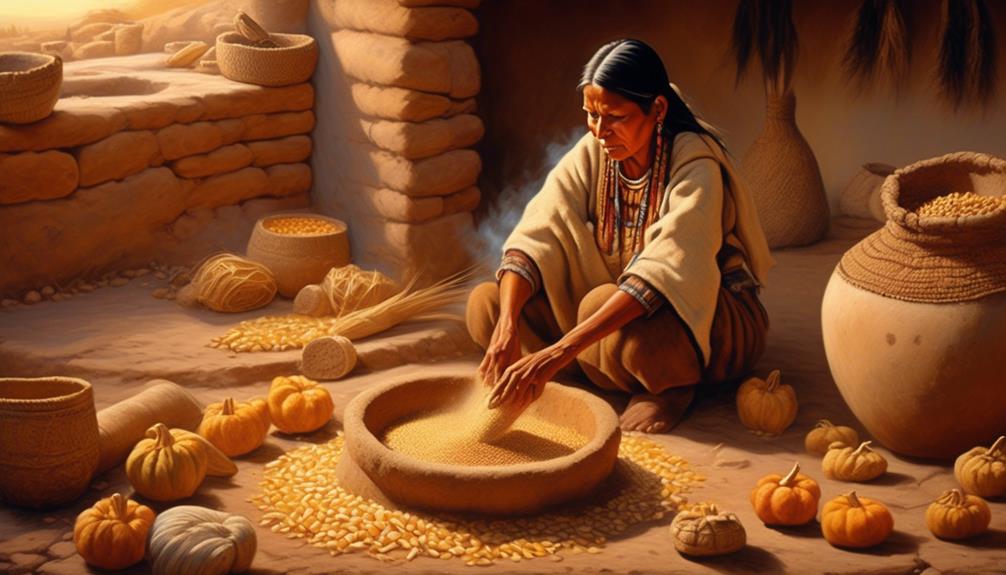
Navigating the intricate terrain of our ancestral lands, we honed our understanding of the natural world to sustain ourselves through hunting and gathering practices, and now, we turn our attention to the art of food preparation techniques. Our cooking methods and preservation techniques were deeply rooted in tradition and practicality, ensuring that the food we gathered could be enjoyed throughout the year. Traditional recipes were passed down through generations, each one holding significant cultural importance. Meal rituals were not just about sustenance but also about honoring our connection to the land and the spirits that guided us.
| Cooking Methods | Preservation Techniques | Traditional Recipes |
|---|---|---|
| Roasting | Drying | Piki Bread |
| Steaming | Smoking | Hominy Stew |
| Baking | Fermentation | Blue Corn Mush |
| Boiling | Pickling | Bean and Squash Stew |
| Grilling | Canning | Sunflower Seed Cakes |
Our cooking methods were adapted to the resources available, and our preservation techniques allowed us to savor the flavors of our harvest year-round. The traditional recipes and meal rituals continue to be cherished, representing the deep cultural connections to our heritage and the land.
Ceremonial Foods
Centuries of tradition and cultural significance are woven into the ceremonial foods of the Hopi Indian Tribe, reflecting our deep connection to our heritage and the spiritual world. Traditional recipes hold a sacred place in our ceremonies, symbolizing the essence of our cultural identity.
Corn, a staple of Hopi life, is central to our ceremonial foods. It represents the cycle of life and the enduring presence of our ancestors. Blue corn, in particular, is used in many of our ceremonial dishes, believed to possess unique spiritual properties. From piki bread, a paper-thin delicacy made from blue corn, to hominy, a key ingredient in various ceremonial stews, each dish carries profound cultural significance.
These foods are prepared with meticulous attention to detail, often involving time-honored techniques passed down through generations. The act of preparing and sharing these ceremonial foods is a deeply spiritual practice, fostering a sense of unity and reverence within the community.
Our ceremonial foods serve as a living testament to the enduring traditions and spiritual wisdom of the Hopi people.
Frequently Asked Questions
How Has Modernization and Contact With Other Cultures Affected the Traditional Diet of the Hopi Indian Tribe?
Modernization and cultural assimilation have significantly impacted the traditional diet of the Hopi Indian Tribe. The introduction of new foods and modern food preservation techniques has altered our indigenous agriculture practices. While these changes have brought some benefits, they've also posed challenges to preserving our traditional dietary practices.
The influence of other cultures has reshaped our culinary traditions, leading to a shift in the types of foods consumed and the methods of food preparation.
Are There Any Traditional Cooking Utensils or Tools That Are Unique to the Hopi Tribe?
Traditional cooking utensils of the Hopi tribe, like clay pots and stone griddles, hold deep cultural significance.
Preserving these tools is crucial for safeguarding our heritage. It's fascinating that each utensil is meticulously handcrafted, connecting us to our ancestors.
These tools are vital for preparing traditional Hopi dishes, keeping our culinary traditions alive.
As we strive to maintain our cultural identity, these unique cooking utensils play a pivotal role in preserving our heritage.
What Role Do Specific Foods Play in Hopi Ceremonial or Religious Practices?
In Hopi culture, specific foods hold significant cultural and ceremonial importance. Traditional ingredients like corn, beans, and squash are central to their religious practices. These ingredients aren't only used in cooking but are also integral to various ceremonial rituals. Cooking techniques are passed down through generations, emphasizing the sacredness of food preparation in their culture.
The cultural significance of these foods reflects the deep spiritual connection the Hopi people have with their traditional cuisine.
How Do Hopi Recipes and Cooking Techniques Differ From Those of Other Native American Tribes?
Hopi cooking methods showcase unique traditions and emphasize food preservation. Traditional ingredients hold cultural significance, and the impact of modernization has influenced the tribe's culinary practices.
The use of traditional cooking tools is integral to their culinary heritage. These techniques differ from those of other Native American tribes, reflecting the Hopi's distinct cultural identity and culinary expertise.
Are There Any Traditional Hopi Dishes or Ingredients That Are No Longer Commonly Consumed or Are at Risk of Being Lost?
There are traditional ingredients and ceremonial foods within Hopi cuisine that are at risk of being lost. Culinary evolution has led to shifts in cooking techniques, which may contribute to the endangerment of certain dishes.
It's important to focus on cultural preservation to maintain the authenticity of Hopi cuisine. By recognizing and safeguarding these endangered elements, we can ensure that future generations continue to experience the rich and unique flavors of our heritage.
Conclusion
In conclusion, the Hopi Indian tribe had a diverse diet that included staple crops, wild edible plants, and hunting and gathering. Despite the misconception that they only ate maize and beans, they also enjoyed a variety of foods such as sunflower seeds, wild berries, and game meats.
Their food preparation techniques and ceremonial foods reflect their rich cultural traditions and deep connection to the land. The Hopi diet was truly a reflection of their unique and vibrant culture.
Mary is a passionate writer who brings creativity and a fresh perspective to our team. Her words have the power to captivate and inspire, making her an essential contributor to our content. Mary’s commitment to storytelling and dedication to promoting Indigenous culture ensures that her work touches the hearts of our readers. We’re fortunate to have her as part of our team.
